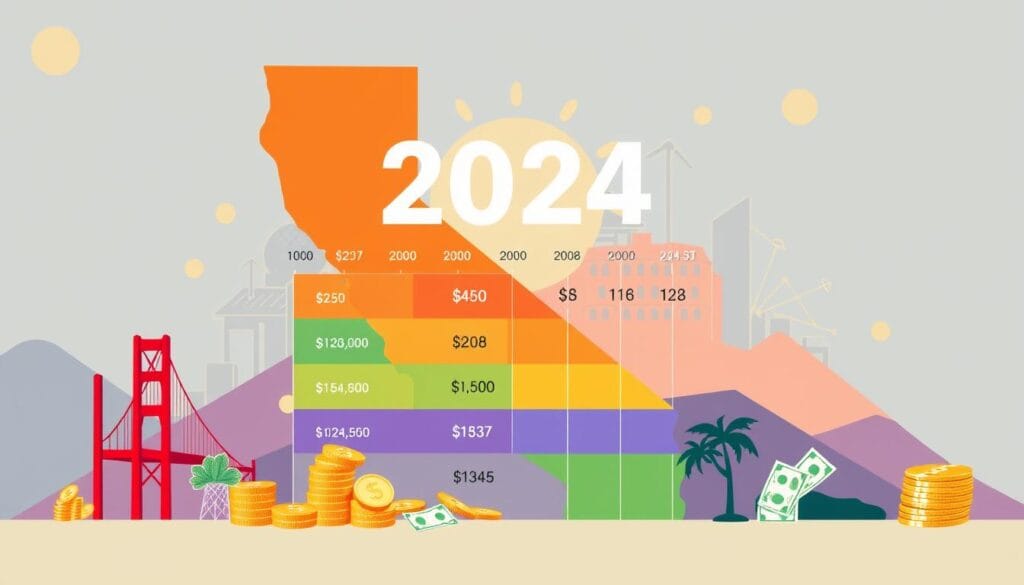Staying informed about California 2024 Tax Brackets is crucial for residents as significant updates to the state’s tax brackets and rates are coming. These changes will directly impact how you plan and file your taxes for the year.
Learning about these changes can help you manage your taxes better. It ensures you meet your tax duties while keeping your finances healthy.
Key Takeaways
- California’s 2024 tax brackets and income tax rates are undergoing significant updates.
- These changes will affect your state tax obligations and planning for the upcoming year.
- Familiarizing yourself with the new tax structure can help you navigate the filing process efficiently.
- Staying informed about deductions, credits, and other tax considerations is crucial for California residents.
- Understanding the 2024 tax landscape can empower you to make informed financial decisions and fulfill your tax responsibilities effectively.
Understanding California’s Tax System Overview
California’s tax system is based on how much you earn. As your income goes up, so does the tax rate. This means people with more money pay more in taxes. It’s important for those living in California or thinking about moving there to understand this.
Progressive Tax Structure Explained
California’s tax system has different rates for different income levels. When you earn more, you move into a higher tax bracket. This way, those with more money pay a bigger share of their income in taxes.
Key Changes for 2024
In 2024, California’s state tax brackets and rates will change. These updates account for inflation and the state’s economic shifts. It’s key for taxpayers to know the new california tax slabs 2024 to pay the right amount of taxes.
Residency Requirements
Who pays California taxes depends on where you live. If you’re a California resident, you pay taxes on all your income. But if you’re not a resident, you only pay taxes on income from California. Knowing the rules about residency is vital for figuring out your taxes.

California 2024 Tax Brackets and Corresponding Rates
As California prepares for the 2024 tax season, it’s key for taxpayers to know the state’s income tax system. The california income tax structure 2024 is progressive, with rates changing based on income. Let’s look at the california taxation 2024 details, including tax brackets and rates.
| Taxable Income Range | Tax Rate |
|---|---|
| $0 – $8,932 | 1% |
| $8,933 – $21,176 | 2% |
| $21,177 – $33,421 | 4% |
| $33,422 – $45,666 | 6% |
| $45,667 – $57,911 | 8% |
| $57,912 – $295,373 | 9.3% |
| $295,374 – $354,445 | 10.3% |
| $354,446 – $590,742 | 11.3% |
| $590,743 and above | 13.3% |
These brackets and rates apply to different filing statuses, like single filers and married couples. It’s vital for taxpayers to check their situation to find the right tax bracket. This helps in accurately figuring out their california taxation 2024 amount.

“Understanding the california income tax structure 2024 is crucial for ensuring you pay the right amount of taxes and maximize your deductions and credits.”
Single Filer Tax Brackets for 2024
If you’re single and living in California, knowing the 2024 tax brackets is key. The state’s tax system is based on how much you earn. This means your taxes will change based on your income. Let’s explore how this affects your 2024 tax filing in California.
Standard Deduction Updates
In 2024, single filers in California will get a standard deduction of $13,200. This deduction can lower your taxable income. It might also put you in a lower tax bracket, which can reduce your taxes.
Income Thresholds
- $0 – $9,990: 1% tax rate
- $9,991 – $24,723: 2% tax rate
- $24,724 – $38,672: 4% tax rate
- $38,673 – $56,324: 6% tax rate
- $56,325 – $286,492: 8% tax rate
- $286,493 and above: 9.3% tax rate
Calculation Examples
Here are a few examples to show how the tax rates work:
- If you make $35,000, you’re in the 4% bracket. Your taxes would be $1,394.80 (4% of $34,800).
- If you make $75,000, you’re in the 8% bracket. Your taxes would be $4,800 (8% of $60,000).
Keep in mind, these examples don’t include all taxes or credits you might get. It’s smart to talk to a tax expert. They can help you get the most deductions and pay the right amount of taxes in 2024.

Married Filing Jointly Tax Rates
When it comes to california 2024 tax brackets, married couples filing jointly have their own rates and thresholds. This status often offers benefits, but it’s key to grasp the california state tax brackets 2024 for married filers.
One big plus of filing jointly is the higher standard deduction. In 2024, this deduction will jump to $27,700 for married couples. This is up from $25,900 in the last year.
| Taxable Income Bracket | Tax Rate |
|---|---|
| $0 – $20,000 | 1% |
| $20,001 – $50,000 | 2% |
| $50,001 – $100,000 | 4% |
| $100,001 – $300,000 | 6% |
| $300,001 – $500,000 | 8% |
| $500,001 and above | 9.3% |
The california 2024 tax brackets for married couples filing jointly differ from those for single filers. Married couples can combine their incomes and claim deductions not available to singles. This can lead to a lower tax bill.
When preparing for the california state tax brackets 2024, talk to a tax expert or use trusted resources. This ensures you’re using your filing status wisely and getting all the deductions and credits you can.
Additional Tax Considerations for California Residents
As a California resident, you need to know about more than just state income tax brackets. You should also think about the Mental Health Services Tax, Alternative Minimum Tax, and local taxes. These can all affect how much you owe in taxes.
Mental Health Services Tax
In 2024, California will start a new Mental Health Services Tax. It will apply to those who make a lot of money. The tax rate is 1% on income over $1 million for singles or $2 million for couples.
Alternative Minimum Tax
California also has an Alternative Minimum Tax (AMT). It makes sure high-income earners pay a fair share of taxes. In 2024, the AMT rate is 7% for singles and 6.5% for couples. You’ll pay the higher of your regular tax or AMT.
Local Tax Obligations
Where you live in California can also affect your taxes. You might face city or county sales taxes, property taxes, and more. Knowing your local tax rules is key to avoiding penalties.
Understanding these extra taxes helps California residents plan for 2024. Stay informed and get help from tax experts. This way, you can make the most of your deductions and meet your tax duties.
Tax Credits and Deductions Available in 2024
When planning your California taxes for 2024, knowing about tax credits and deductions is key. These can lower your tax bill and save you money.
The California Earned Income Tax Credit (CalEITC) is a big help for 2024. It’s a refundable credit for those with lower incomes. The Young Child Tax Credit (YCTC) also helps families with young kids.
Homeowners can benefit from the California Mortgage Interest Deduction. It lets you deduct mortgage interest, reducing your taxable income. The Charitable Contributions Deduction also helps by letting you deduct donations to charity.
To make the most of california tax planning 2024 and california income tax structure 2024, talk to a tax expert or use tax software. They can guide you through the tax system and find ways to lower your taxes.
| Tax Credit/Deduction | Description | Eligibility Criteria |
|---|---|---|
| California Earned Income Tax Credit (CalEITC) | A refundable tax credit designed to benefit low-to-moderate income individuals and families. | Based on your earned income, filing status, and number of qualifying children. |
| Young Child Tax Credit (YCTC) | An additional tax credit for families with young children. | Applicable to families with children under the age of 6. |
| California Mortgage Interest Deduction | Allows homeowners to deduct the interest paid on their mortgage. | Available to taxpayers who itemize their deductions. |
| Charitable Contributions Deduction | Enables you to deduct eligible charitable donations from your taxable income. | Applicable to taxpayers who itemize their deductions. |
Filing Deadlines and Payment Options
As the 2024 tax season gets closer, it’s important for California residents to know the filing deadlines and payment options. Here are the key dates and requirements for California tax filing in 2024:
Electronic Filing Requirements
The state of California encourages taxpayers to file their returns online. This makes the process faster and reduces errors. Most tax software providers offer e-filing services, making it easy and efficient.
Extension Guidelines
- If you can’t file by April 15th, you can get a six-month extension.
- To get this extension, you must file Form FTB 3519 by the original due date. This will extend your deadline to October 15th.
- Remember, an extension to file doesn’t extend the payment due date. You still need to pay any taxes owed by April 15th.
Payment Plans
If you can’t pay your California state taxes by April 15th, the state offers several payment plans:
| Payment Plan Type | Eligibility Criteria | Key Features |
|---|---|---|
| Installment Agreement | Taxpayers who owe $25,000 or less in total taxes | Allows for monthly payments over a 60-month period Accrues interest and potential penalties |
| Offer in Compromise | Taxpayers who are unable to pay their full tax liability | Allows for a reduced tax payment based on the taxpayer’s financial situation Requires detailed financial documentation and approval by the state |
By knowing the filing deadlines, electronic requirements, and payment options, California taxpayers can meet their state tax obligations on time and correctly.
Conclusion
Learning about California’s 2024 tax brackets and rates is key for good financial planning. The state’s tax system changes based on how much you earn. This can greatly affect how much you pay in taxes.
Knowing the changes and rules for 2024 helps you prepare your taxes right. Keep an eye out for any new tax rules or changes. California’s tax rules can change often.
Good tax planning means looking at all the deductions and credits you might get. It also means knowing what extra steps you might need to take. By planning well, you can save money and follow the law.
FAQ
What are the California 2024 tax brackets?
California’s 2024 tax brackets and rates have changed. It’s important to know these updates for accurate tax planning and compliance.
How does California’s progressive tax structure work?
California’s tax system is progressive. This means higher incomes pay more in state taxes. It’s fair and ensures everyone contributes based on their earnings.
What are the key changes to California’s tax system for 2024?
For 2024, California’s tax system has seen changes. These include updates to tax brackets, standard deductions, and more. Staying informed is key for effective tax planning.
What are the residency requirements for California tax purposes?
California has rules for tax residency. Knowing if you’re a full-time, part-year, or nonresident affects your taxes. It’s important for your tax filing.
How can I calculate my California state taxes for 2024?
To figure out your 2024 California state taxes, use the updated brackets and rates. Remember your filing status and any deductions or credits. A tax pro or software can help with the math.
What are the 2024 tax brackets and rates for married couples filing jointly in California?
The 2024 tax brackets and rates for married couples filing jointly in California have changed. Knowing these can help you save on taxes and plan your filing.
Are there any additional tax considerations for California residents in 2024?
Yes, California residents in 2024 should consider extra taxes. This includes the Mental Health Services Tax and Alternative Minimum Tax. Knowing these can help with your tax planning.
What tax credits and deductions are available to California residents in 2024?
California offers tax credits and deductions for 2024. These can lower your state tax bill. Learning about them can help you get a bigger refund or pay less.
What are the filing deadlines and payment options for California state taxes in 2024?
California’s 2024 tax filing deadlines and payment options are clear. Knowing these, including electronic filing and payment plans, is crucial for avoiding penalties.

